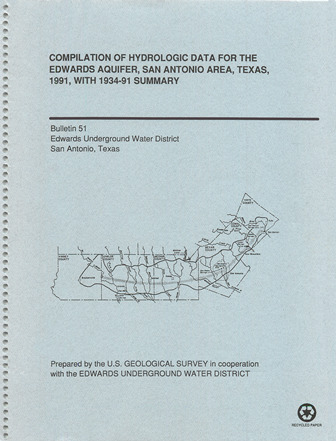1991 Hydrologic Data Report – Compilation of Hydrologic Data for the Edwards Aquifer, San Antonio Area, Texas, 1991, with 1934-91 Summary

| Author | Brown DS, Petri BL and Nalley GM (US Geological Survey) |
| Year | 1992 |
| Description | Annual report for 1991 on recharge, discharge, water levels and water quality in the Edwards Aquifer San Antonio Region |
| Report Number | Bulletin 51 |
| Publisher | Edwards Underground Water District |
| Location | Edwards Aquifer - San Antonio Area |
| Cover | View Download |
| File | View Download |
| Summary |
|
The average estimated annual ground-water recharge to the Edwards aquifer in the San Antonio area, Texas, from 1934 through 1991 was 651,700 acre-feet. Recharge in 1991 was 1,508,400 acre-feet, which is the third largest estimated annual recharge since 1934. The maximum annual recharge of 2,003,600 acre-feet occurred in 1987, and a minimum annual recharge of 43,700 acre-feet occurred in 1956. The estimated annual discharge from the Edwards aquifer by wells and springs in 1991 was 790,300 acre-feet, which is the fourteenth largest calculated annual discharge since 1934. Annual discharge by wells and springs ranged from a maximum of 960,900 acre-feet in 1977 to a minimum of 388,800 acre-feet in 1955. Water-level data for wells during 1991 reflected a less-than- to about average volume of ground water in storage in the aquifer during most of the year. Water samples from 61 wells (including wells drilled in 1985 that transect the freshwater/saline-water interface) and 3 springs in the Edwards aquifer were analyzed for more than 90 properties or constituents, most of which affect the suitability of the water for domestic use. Concentrations of constituents in water from three wells completed in the freshwater zone exceeded the maximum contaminant levels established for public water systems. Trace concentrations of volatile organic compounds were detected in samples from seven wells. Surface-water data for the San Antonio area, which were used to calculate annual recharge to and annual discharge from the Edwards aquifer, consisted of discharge data for streams and springs and contents data for reservoirs. The data are stored in the National Water Information System, a computerized data base operated by the U.S. Geological Survey. |
Search for Documents
Advance Search
Explore EAA's Scientific Reports
- All Reports
- Groundwater Movement
- Geomorphology and Caves
- Weather Modification
- Geology
- Water Use and Conservation
- Geochemistry
- Water Resources Planning and Management
- Floods and Drought
- Water Quality
- Climatology
- Surface Water / Groundwater Relationship
- Biology
- Springs, Groundwater Discharge
- Archaeology
- RZ Protection
- Aquifer Levels
- Remote Sensing
- Precipitation
- Overview Studies
- Modeling
- Hydrology and Hydrogeology
- History
- Groundwater Recharge, Recharge Zone
